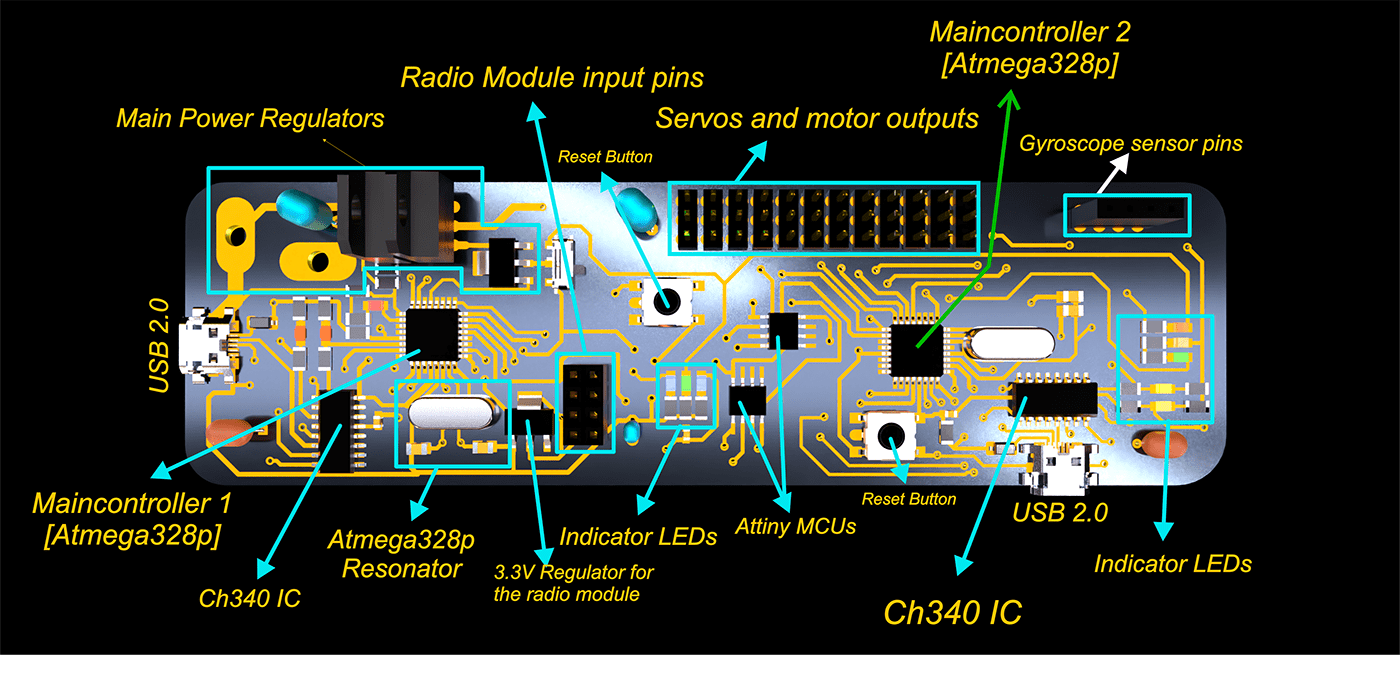This PCB is the 2nd Generation and the 3rd Version of the series: Airplane Flight Controller
Version 1: Airplane Controller V1
Version 2 Part 1: Airplane Controller V2 [Receiver]
Version 2 Part 2: Airplane Controller V2 [Flight Controller]

This Version has many advantages on top of the 2nd version in terms of:
1- Noise Reduction
It has no floating signal wires whatsoever and above that all the main controlling ICs (Integrated Circuit) are of the SMD (Surface Mount Device) type beside the much better wire traces arrangement (Ground wire surrounding the whole PCB). the whole airplane controller was ultra compact [a 14x4 cm board] with much better performance than the old [2 Separate Parts] PCB.
2- Programming:
This is my first ever programmable PCB. Implementing the CH340 Programming IC was a huge step in designing the controller. The main reason to do this upgrade is that i would no longer need to remove the ICs and program them one by one, which was a very hard thing to do and sometimes burnt the ICs by misplacements.
3- Power Regulation
- The old PCBs had no form of power regulation at all; the PCBs were being powered directly from the motor's ESC (Electronic Speed Controller) which had many problems associated with noise as they are relatively sharing the same line. Sharing the same line with a high power motor sometimes caused a noticeable underperformance in the main controller ICs that caused it to stop responding or sometimes even reset itself that which at this point the whole system fails. Beside those input power problems there where problems in the old PCBs' traces size that caused them to burn at high current consumption caused by the servos.
- In the 3rd version of the controller, I took care of those problems by supplying the board with power directly from the battery passing through relatively high power regulation ICs and by that I got rid of all the fluctuations on the main power line entering the PCB. I also increased the size of the main power delivery traces going to the servos so that they wont burn any more
4- Functionality and shape:
- This version has much more functionalities on top of the older ones which i mentioned some of them before. One of the major functionalities added this version was the ATtiny microcontrollers which have the role of controlling the retractable landing gear and the bombing mechanisms.
- Coming to the shape, The old versions of this controller, as you might have seen in my profile, has a very bad, unprofessional and unorganized look; let's take the version 2 as an example which was split into two parts and had many unimportant components that was taking place on the board thinking from me that i could use them later, but i never had.
- On the other hand, this version has an ultra organized and much nicer look; i even took care of the indicator LEDs placements on the board so that it looks as professional as possible. I even used USB 2.0 to program the board, so fancy isn't it?



In this controller I'm using:
- Two Atmega328p ICs as the main controllers [one as a receiver and the other processes the signal and exports motor movements (as a flight controller)] along with their required resonators to work.
- Two CH340 ICs to program the, previously mentioned, Atmega328p ICs .
- Two Female USB 2.0 as a programming line between the IDE and the CH340 IC.
- Some SMD Schottky Diodes at the USB input To prevent reverse current to the device.
- Two Attiny45 Microcontrollers as the landing gear and bombing mechanism controller.
Voltage regulators as:
- Ams1117 3.3V for the radio module
- Ams1117 5V for the Atmega328p and the ATtiny45.
- 7805 IC Specifically chosen for the servos output pins.
- Various Capacitors to decrease voltage fluctuations.
- Push buttons to reset the board.
- Many LEDs as statuses indicators.






